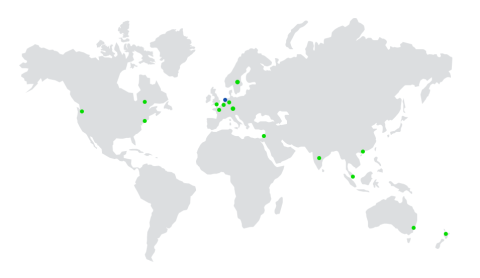
Portfolio management and property planning
Property management software supports the automation of processes such as portfolio management, transaction management, lease management and (capital) project management for real estate owners and occupiers.
Property management software is mainly used within the following sectors: residential housing, hotel and hospitality industry, commercial real estate or corporate real estate. Property and real estate managers have unique needs when it comes to technology and software. This becomes even more challenging due to the different roles and responsibilities in property and real estate management. There are many solutions on the market that meet these specific needs, either as a point solution or as integrated software. Of course this also means that the average cost of property management software can vary considerably.
How is property management software used?
There are different uses for property management software. The property management function within an Integrated Workplace Management System (IWMS) usually focuses on corporate real estate processes (CRE) for both property owners and occupiers. In real estate management, an IWMS typically supports business processes such as lease management, portfolio and real estate asset management, transaction management, (capital) project management and strategic property planning. Different to a standalone property management system or other tools, an IWMS integrates these property management functions with adjacent processes such as maintenance management, sustainability, facility management, space management and workplace optimisation.
Financial considerations
The huge financial impact that is involved in corporate real estate for large organisations and multinationals combined with the increasing need for portfolio transparency, compliance and business continuity, builds an immediate business case for the implementation of property management software. Particularly software that combines the functionality of multiple property management solutions into a single property management system. Markets and demographics are rapidly changing, which means that organisations that exploit and operate many branches or locations have an urgent need for property management systems. Banks, retailers, and the pharmaceutical, production or hospitality industries need fast acquisition and sale of properties, timely lease cancellations or renegotiations, and assets that correctly represent their brand.
Learn more about property management software

Uppnå full synlighet i fastighetsportföljen med IWMS och ERP-system
Förbättra fastighetshanteringen samtidigt som du utforskar fördelarna med ERP/IWMS-integrering.
Lär dig mer
Hållbara fastigheter med SAP och Planon: 6 frågor & svar
FAQ om att koppla samman SAP ERP med fastighetsförvaltning.
Lär dig mer
Uppnå hållbara resultat med integrerade RE- och ERP-lösningar
Se Forresters webbinarium med SAP och Planon för att lära dig mer om RE-trender, RE-hanteringslösningar med positiv påverkan både på drift och ekonomi samt fördelarna med integrerade RE- och ERP-lösningar.
Lär dig merLease management and lease accounting
The core functionality of any property management software is managing leases for landlords or tenants. Combining lease management for lessors and lessees into one software solution allows corporate real estate organisations to manage both their owned and rented real estate in the most efficient and effective way. In both situations all financial aspects of lease management such as lease payments, lease incomes, financial forecasting, price adjustments, price indexing and service costs calculations are managed and reported within a single integrated software solution.
Individual lease contracts can often include complex arrangements and deviations, therefore property management software is a need for any organisation that has multiple lease and rent contracts. This allows organisations to assess rental options, renew and archive contracts, monitor the resulting financial and legal obligations by automated notifications for deadlines or cancelations, and proactively align their real estate supply with future business demand – in a timely manner.
New lease accounting regulations
In lease accounting, the Financial Accounting Standards Board (FASB) and the International Accounting Standards Board (IASB) introduced changes to the way leases are classified and the way lease costs are defined. These changes affect the P&L and balance sheets of most organisations and the lease administration practice of corporate real estate managers, accountants and controllers. The changes include the requirement for companies to capitalise operating leases and include them as assets and liabilities on the balance sheet. It also includes a change in the definition of a lease payment, which will include certain variable rents, contractual payments and renewal rents. The scope of the changes includes leases on many types of assets and real estate related leases for companies reporting under US-GAAP (FASB) and IFRS (IASB).
Real estate management and property portfolio planning
Successfully managing properties and real estate starts with accurate data and transparency. As a part of the property management function, portfolio management software provides a clear and standardised overview of your real estate assets including information such as technical conditions, space and workplace utilisation, scenario planning, CAD visualisation and portfolio reporting. These systems ensure that the real estate strategy and portfolio is in line with your organisation’s objectives. Strategic real estate scenario planning also helps to analyse your actual portfolio’s performance against organisational goals and identify the gaps in your current strategy. It also offers tools to fill in these gaps with functionality for transaction management to acquire or dispose of properties, or to help with capital project management in planning, managing and controlling capital expenses.
"85% of real estate and facilities managers say space utilization is important in shaping the firm's real estate strategy from now until 2021."
- Verdantix
Find out more in our white paper focusing on Capital Project Management.
Portfolio management software
With portfolio management software, organisations can quickly and easily review the total cost of ownership (TCO) for all real estate properties and make accurate financial decisions based on facts. By presenting a holistic view of your real estate assets, these solutions provide you with the means to make strategic decisions based on the expected life cycle of your buildings. This allows executives to identify areas where significant cost savings can be made and gives the information needed to accurately project future capital flows.
A property management system that includes portfolio management, in most cases labelled as IWMS, supports organisations in standardising both data and processes to ensure reliable and compliant reporting and allows internal or external benchmarking.
Infographic - Get in control of your real estate, lease contracts and financial obligations

Property management software and IWMS
By combining real estate and property management software in one IWMS, organisations can enjoy many advantages. All property data is registered only once in one single database and is used by many processes in real estate, maintenance, space, facility and sustainability management. This ensures high data quality and corresponding KPI reporting and portfolio analysis. By integrating these different processes, the strategic, tactical and operational handling of all building and property related activities are managed from within one integrated solution. This increases the opportunity to identify and implement improvements and can help to reduce the TCO of your portfolio.
An IWMS includes proven systems integration capabilities with important systems such as geographical information systems (GIS) for visualising portfolio mappings, Building Information Modeling (BIM) for maximising the reuse of design and as-built information during the property lifecycle, and Enterprise Resource Planning (ERP) systems like SAP to integrate with core financial processes. Combining real estate management data with ERP data and processes can result in improved decision-making, operational agility, and property sustainability. Read the answers to six common questions about integrating a real estate management software solution into an ERP solution.
Global success stories

Carglass®
Frank Roosen, Facility Manager: “Customer delight and business continuity with Accelerator.”
Upptäck mer
Bayer Real Estate
Michael Müller, Managing Director Bayer Real Estate: "Successful RE and FM with Planon."
Upptäck mer
Ahold Delhaize
Ahold Delhaize has used Planon software since 2005 to support facility and maintenance services for its Dutch headquarters, distribution centres and home shop centres.
Upptäck mer


















